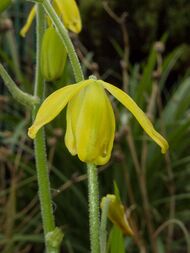Biology:Albuca shawii
| Albuca shawii | |
|---|---|

| |
| Scientific classification | |
| Kingdom: | Plantae |
| Clade: | Tracheophytes |
| Clade: | Angiosperms |
| Clade: | Monocots |
| Order: | Asparagales |
| Family: | Asparagaceae |
| Subfamily: | Scilloideae |
| Genus: | Albuca |
| Species: | A. shawii
|
| Binomial name | |
| Albuca shawii Baker[1]
| |
| Synonyms[1] | |
| |
Albuca shawii is a species of bulbous plant from southern Africa. It flowers in the summer and has yellow flowers on stems to about 30 cm high.
Description
Albuca shawii is a summer growing and winter dormant bulbous plant, flowering from September to February in its native habitat in southern Africa. It has narrow, somewhat fleshy leaves covered with short, slightly sticky hairs. The flower stems are around 30 cm tall and carry nodding flowers with tepals about 15 mm long, yellow with green stripes. The flowers are scented.[2][3]
Taxonomy
Albuca shawii was first described by John Gilbert Baker in 1874.[1] The specific epithet shawii commemorates the collector, named by Baker only as "Dr Shaw",[4] and identified elsewhere as the Scottish botanist John Shaw.[2] Baker placed the species in a new series within the genus Albuca, Leptostyla, noting both its long, thin style and the sterile outer stamens.[4]
Along with other species of Albuca, A. shawii has been placed in the genus Ornithogalum (as O. shawii), but molecular phylogenetic studies have supported the separation of the two genera.[5] The species has been synonymized with Albuca tenuifolia, but this has been rejected.[6]
Distribution and habitat
Albuca shawii is native to southern Africa (the Cape Provinces, Lesotho, KwaZulu-Natal, the Free State and the Northern Provinces).[1] It grows on cliffs and rocky grassland at elevations of 150–2400 m.[2]
References
- ↑ 1.0 1.1 1.2 1.3 "Albuca shawii", World Checklist of Selected Plant Families (Royal Botanic Gardens, Kew), http://apps.kew.org/wcsp/namedetail.do?name_id=294633, retrieved 2016-02-05
- ↑ 2.0 2.1 2.2 Albuca shawii, Pacific Bulb Society, http://pacificbulbsociety.org/pbswiki/index.php/Albuca_shawii, retrieved 2016-02-06
- ↑ Albuca shawii, Royal Horticultural Society, https://www.rhs.org.uk/Plants/764/i-Albuca-shawii-i/Details, retrieved 2016-02-06
- ↑ 4.0 4.1 Baker, J.G. (1874), "Description of new species of Scilleae and other Liliaceae" (in Latin), Journal of Botany 12: 363–368, https://www.biodiversitylibrary.org/page/34897956, retrieved 2016-02-06, p. 367
- ↑ Martínez-Azorín, M.; Crespo, M.B.; Juan, A.; Fay, M.F. (2011), "Molecular phylogenetics of subfamily Ornithogaloideae (Hyacinthaceae) based on nuclear and plastid DNA regions, including a new taxonomic arrangement", Annals of Botany 107 (1): 1–37, doi:10.1093/aob/mcq207, PMID 21163815
- ↑ Martínez-Azorín, Mario; Crespo, Manuel B.; Dold, Anthony P. (2012), "Albuca tenuifolia and A. shawii, two distinct species from South Africa", Bothalia 42 (2): 193–196, https://www.researchgate.net/publication/232613532_Hyacinthaceae_Albuca_tenuifolia_and_A_Shawii_Ornithogaloideae_two_distinct_species_from_South_Africa, retrieved 2016-02-06
Wikidata ☰ Q15517325 entry


